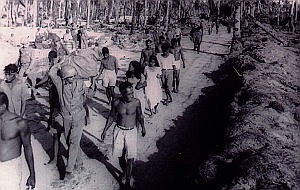 |
KWAJALEIN ATOLL REPUBLIC OF THE MARSHALL ISLANDS |
 |
| HOME | LIVING | AVIATION | MARINE | PET INFO | * HISTORY * | ISLANDS | LINKS | MEDIA | PHOTOS | SERVICES | SITE MAP | ABOUT |
 |
KWAJALEIN ATOLL REPUBLIC OF THE MARSHALL ISLANDS |
 |
| HOME | LIVING | AVIATION | MARINE | PET INFO | * HISTORY * | ISLANDS | LINKS | MEDIA | PHOTOS | SERVICES | SITE MAP | ABOUT |
| H I S T O R Y | |||||||||
| BEFORE WWII |
DURING WWII |
1944 BILL ILES |
1944 CURTIS PARTCH |
1947 ED SPILMAN |
1950 - 1951 GENE WOOLIEVER |
1951 - 1969 |
1970 - 1989 |
1990 - 1994 |
HISTORY COMES ALIVE |
 |
WWII history comes alive |
| Jillo Lantir** remembers the 1944 American invasion of Kwajalein. She endured the battle inside a bunker on Carlson, or Ennibuoj, with 20 or more other islanders and no food or water.
"I came out of the bunker because I was thirsty," she said, with the help of translator Moss Phillip. "I was scared, but I remembered what my father said. When I'm scared, I can't act scared or I will not survive, or something bad will happen."
Lantir, an alap, or landowner, on Kwajalein, Carlson, and Carlos islands, and six other Marshallese elders shared their stories of the war years with Kwajalein community at the Religious Education Building last week. Phillip and Alter Langrine served as translators for the group. The event was sponsored by the Marshallese Cultural Society. Dr. Eric Lindborg, President, and Cris Lindborg, Director of Exhibits at the Marshallese Cultural Center, organized the unique program. More than 50 people filled the room to hear the tales. Pictures from Operation Flintlock, the invasions of Kwajalein, Roi, and Namur Islands, lined the back wall. Long-time resident Pat Cataldo gave an overview of the Japanese era in the Marshall Islands, 1914-1944. At the front of the room, however, sat living history - a panel of seven Marshallese who lived through the war years on different islands and under different circumstances. Lantir, for example, left her bunker to find war dead strewn along the beach. She sat and drank from a canteen she took from a dead soldier. Shortly afterward, American soldiers approached her, rifles pointed at the ready. Frightened, she couldn't speak Marshallese or English. Instead, her words came out in Kosraean. Fortunately, American soldiers took her to a field station, where she was given food and water. Nearty Korok, an alap of Erro, in the mid-atoll corridor, survived in a bunker on Kwajalein during the bombardment. Having come to the island in September 1943 for medical treatment, the then 11-year-old girl lived with siblings. One sister's husband worked on Kwajalein for the Japanese. Then bombs began to fall. |
 |  |
|
"There was no place to hide except for the bunker where they stored weapons and stuff," she said. " Everywhere, there was fire and smoke, across the sea and along the islands. There were many deaths. Marshallese asked to leave, but the Japanese commander was very bad, so he just kept us here. A meeting was held, and finally only women and children were taken home."
Korok left on a boat with other women and children. On her way off the island, her boat passed another filled with Japanese soldiers she claimed were and their way to beheading Marshallese, but the Americans came and started firing on them. I went home but the battle went on." Akira Kobney, an alap of Roi-Namur, drove a similar boat. Kobney said shortly before U.S. Marines stormed the beaches on Roi and Namur, Japanese told him to take Marshallese women and children on a 25-foot boat from Third Island to Ajkan, an island near Roi and Namur. There, he and the others sat out the battle. Meanwhile, Wanjor Balos, an alap from Kwajalein, was on Jaluit, where he worked as principal of a school. The Japanese had started the school for 400 Marshallese students, and Balos said, "Japanese were very nice. Before the invasion, during that time, they were very strict." Piton Subilee, an alap from Carlson, who worked for Japanese on Kwaj, Gugeegue, and Namur, agreed that the Japanese were not all bad. "I tell you, working with the Japanese was OK," Subilee said. "Once you do something wrong, that's when you got beaten up and that's when they punished you. They were nice, just like you." Nalon Langio, wife of alap Ato Langio, of Kwajalein, was only 8 years old in 1944 and lived on Carlos. She doesn't remember the battle as much as the results. "When I was a little girl, I heard all the stories I wanted to of it. Those people were scared, naked ... All I could hear was crying, mourning," she said. "Thank you Americans for saving us." Daisey Levai, an alap of Ebadon, who was also young and off-island at the time of the attack, echoed Langio's words. As the stories concluded, members of the crowd crowded around the Marshallese to ask questions. Others gathered in small groups over cake and punch and spoke of what they had heard. "This puts a human dimension behind the stories, behind the pictures," Dr. Lindborg said. |
| H I S T O R Y | |||||||||
| BEFORE WWII |
DURING WWII |
1944 BILL ILES |
1944 CURTIS PARTCH |
1947 ED SPILMAN |
1950 - 1951 GENE WOOLIEVER |
1951 - 1969 |
1970 - 1989 |
1990 - 1994 |
HISTORY COMES ALIVE |